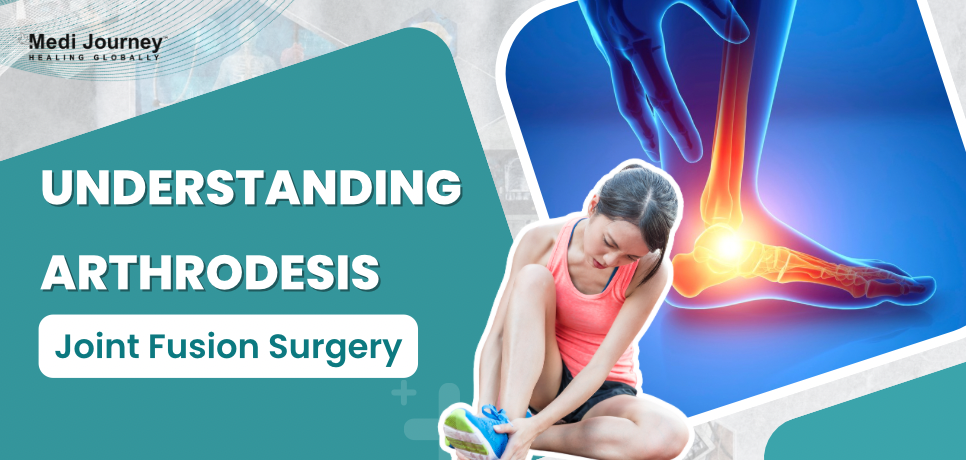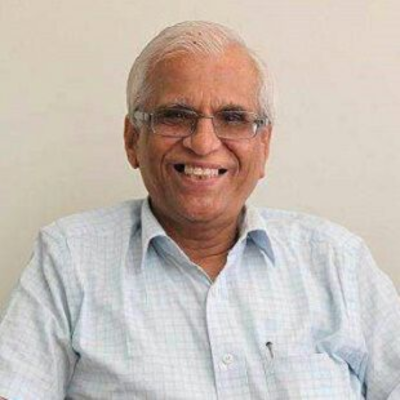The Role of Government Initiatives in Promoting Medical Tourism in India
 02 April,2025
Read More
02 April,2025
Read More
Enquire now in case of any assistance needed

Living with chronic joint pain can significantly hamper your daily life. While conservative treatments like medication and physical therapy can offer relief, sometimes a more permanent solution is needed. Arthrodesis, also known as joint fusion surgery, might be the answer you've been looking for. This procedure offers significant pain reduction and improved stability, but it's essential to understand what it entails.
In this blog, we'll explore the purpose of joint fusion surgery, the recovery process, and the potential benefits and drawbacks. So, if you're considering arthrodesis, keep reading to get the complete picture!
Arthrodesis or joint fusion surgery is an orthopedic procedure in which the surgeon joins the two diseased bones. The surgeon removes the cartilage between the bones and straightens them to unite together. It can be performed on different body joints, such as the ankle, spine, feet, wrist, thumbs, and fingers.
Arthrodesis helps relieve excruciating joint pain. The movement between the joints causes pain in arthritis and other orthopedic conditions. The surgeon eliminates the pain by fusing two bones together and making them one. The surgery also helps make the joint more stable and allows you to bear more weight.
Common joint fusion surgeries are –
Arthritis is the primary reason why orthopedic surgeons advise joint fusion surgeries. The disease diminishes the cartilage and causes severe damage to the joints. In such conditions, fusing bones together significantly reduces joint pain. Apart from arthritis, other orthopedic conditions, such as scoliosis, bone fractures, spondylolisthesis, and degenerative disc disease, may also warrant the need for arthrodesis.
A good candidate for joint fusion surgery is one who has tried traditional treatments such as pain medicines and physical therapy but still experiences pain. However, there are several conditions that might stop patients from undergoing arthrodesis. These include –

Arthrodesis or joint fusion surgery is a safe procedure with a fusion rate of 80 to 100%. It offers several benefits such as –
Arthrodesis does have some general risks associated with every surgery. Risks of joint fusion surgery include –
Before undergoing a joint fusion surgery, you will meet your orthopedic surgeon, who will ask you about the symptoms you are suffering and how much they affect your everyday life. They will also ask about the nonsurgical treatments that you have tried and how effective they were.
Once the surgeon establishes that you are the right candidate for a joint fusion surgery, they will explain the whole procedure to you, along with the risks and benefits. The doctor will perform a physical examination to check joint function and order blood tests and radiological studies such as X-rays, MRI, and CT scans.
Tell your doctor about all your medications, including OTCs, herbal drugs, and supplements. Some medicines might cause complications during joint fusion surgery or interfere with the healing process after the surgery. Hence, these might be stopped a few days before the procedure.
Our surgery team will also advise you to stop smoking and drinking a week or two before arthrodesis. You are also required to stop eating and drinking 12 hours prior to the surgery.
The surgeon can perform arthrodesis either on an outpatient basis or you may be admitted to the hospital, depending upon your general health and joint condition. There are several ways by which arthrodesis can be performed. A general procedure involves following steps.
A complete healing from joint fusion surgery or arthrodesis may take up to 12 weeks. You will need to wear braces or a cast to protect the joint.
Arthrodesis is a powerful tool for managing chronic joint pain and regaining stability. While it's a major surgery with a recovery period, the potential for long-term pain relief and improved function can significantly enhance your quality of life. If you're considering arthrodesis, consult a qualified orthopedic surgeon to discuss your situation and determine if it's the right option. Together, you can create a personalized treatment plan to get you back to moving with confidence.
Doctor of Pharmacy
Dr. Deepanshu Siwach is a skilled clinical pharmacist with a Doctor of Pharmacy degree.?He has 4+?years of experience and has worked with thousands of patients. He has been associated with some of the top hospitals, such as Artemis Gurgaon.
Director
Orthopedic and Joint Replacement Surgeon
Dr. Aman Dua is a leading Orthopedic and Joint Replacement Surgeon in New Delhi with over 24 years of experience. He has performed over 4,500 joint replacement surgeries on the hip and knee. His surgical expertise includes complex total hip and knee replacement, computer-navigated surgeries, realignment osteotomies of the knee, and the use of bone allograft in joint surgeries....
Senior Consultant
Medical Oncologist
Nanavati-Max Super Speciality Hospital, Mumbai
Book Appointment WhatsApp UsSenior Director
Gynecologist and Obstetrician, IVF Specialist
Max Super Speciality Hospital, Shalimar Bagh, New Delhi
Book Appointment WhatsApp UsSenior Director
Gynecologist and Obstetrician, IVF Specialist
Max Smart Super Speciality Hospital, Saket, New Delhi
Book Appointment WhatsApp UsSenior Director
Gynecologist and Obstetrician
Max Smart Super Speciality Hospital, Saket, New Delhi
Book Appointment WhatsApp UsSenior Director
Gynecologist and Obstetrician
Max Smart Super Speciality Hospital, Saket, New Delhi
Book Appointment WhatsApp UsSenior Director
Gynecologist and Obstetrician
Max Smart Super Speciality Hospital, Saket, New Delhi
Book Appointment WhatsApp UsFill up the form and get assured assitance within 24 hrs!
The Art of Effective Communication
 24 January,2025
Read More
24 January,2025
Read More
Trusted by Patients
"I am Asim from Bangladesh and was looking for treatment in India for neuro. I visited many websites to get the complete information regarding the treatment but I was not satisfied as I was getting confused. In the meanwhile, one of my friends suggested I seek help from Medi Journey as he experienced his medical journey very smoothly and was satisfied with it. They have filtered the top 10 doctors as per experience, the success rate of surgery & profile, so it helps us to choose the best treatment in India. "
"For my knee surgery, Medi Journey guided me to BLK Hospital where I received exceptional care. The team's support and the expertise at BLK Hospital exceeded my expectations. Thank you Medi Journey for making my medical journey stress-free. "
"I came from Iraq for my granddaughter's eye surgery in India facilitated by Medi Journey, due to critical cases they advised us to get a second opinion from the different hospitals before going to surgery. Finally, we went to Fortis Escort Hospital, which helped us to get more confidence for diagnosis. Fortis Escort Hospital has the best eye surgeon team with the latest instruments. Thanks to all team members for providing a high-quality treatment in India at an affordable cost. "
"I came for my hair transplant in India, before coming I was so confused about choosing the best clinic and surgeon for me. But thanks to God one of my friends had a hair transplant in India through Medi Journey. He recommended me to go with them. I am completely happy with my experience with them. They were always very fast in their responses to me. the success rate of my hair transplant surgery is 100%."
"Artemis Hospital, suggested by Medi Journey, turned out to be a great choice for my treatment. The personalized assistance and medical care were exceptional. I'm grateful to Medi Journey for guiding me to a hospital that perfectly matched my needs. Highly recommended! "
"I came from Afghanistan for my treatment in India at Jaypee Hospital, Noida. I had a fantastic experience with Medi Journey. Kudos to them for their incredible support during my medical journey. They not only took care of all the logistics but also connected me with a fantastic healthcare team. Efficient, caring, and highly recommended for a hassle-free medical tourism experience."
"I am Adam from Kano, Nigeria, one of my friends from Nigeria was facilitated by Medi Journey, and he recommended us to go with them. I sent my all reports to them and within 48 hours they reverted with 4 options from different hospitals. They helped me to get a Visa letter from the hospital, arrange pick-up from the airport, and book a hotel for me. Their team is very honest and throughout our stay in India they are with us they are caring for us like his family members. BLK Hospital is the best hospital in India with a top surgical oncologist surgeon team, a very advanced OT, and a Radiotherapy department. I wish more success to Medi Journey. "
"Great experience at the Max Hospital for my spine surgery and was successfully done. I thank my neurosurgeon and his entire team. I recommended all of my country's people to Medi Journey for treatment in India, they choose the best hospital, the best doctors, and the best cost for patients."
"I came to India from Dhaka, Bangladesh for my father-in-law's cardiac surgery at Fortis Hospital. I was confused about choosing the best surgeon for him before coming, but their team helped me to choose the best hospital and best cardiac surgeon in India with very good cost and 100% success rate of surgery. I am very happy with the services, really they make my journey so comfortable that make me feel at home. Thanks again and I like people to choose "Medi Journey" as your travel guide. "
"I am Mohammad from Bangladesh came to India for my general health checkup. Medi Journey offers me the complete package including Pick-up from the airport, hotel services, and 24-hour assistance. They guide you to choose the best hospital in India, the best cost of treatment with top-most doctors and give you complete information about hotel booking, and pick-up from the airport before coming to India They have the best team to help. Always choose Medi Journey for your treatment in India."





